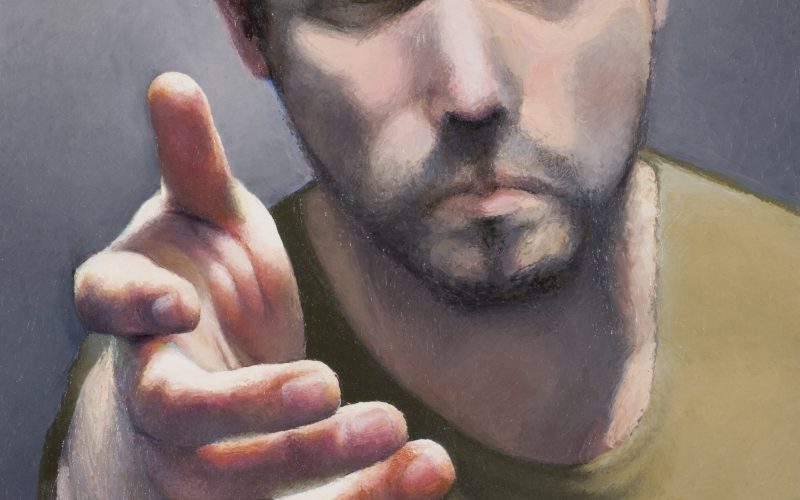
Local artist Adam Campbell looks through a sytrofoam sculpture that will be used to represent the moon in an upcoming art project.
Fayetteville artist Adam Campbell has spent most of his life as a student. He is currently studying at the University of Arkansas, and will graduate this May. Before moving to Arkansas, the Oklahoma native spent years as a student and teacher at the Tulsa School of Metaphysics, where he delved into a variety of religious and spiritual studies and practices.
Campbell first became interested in meditation and metaphysics as a teenager when he was exposed to eastern philosophy through the practice of Wing-Chun Kung-Fu. In the face of adolescent challenges, Campbell turned to spirituality to “make learning hard life lessons a little easier.”
In his senior year of high school, Campbell found that tapping into his artistic abilities bred anxiety, especially when creating self-portraits or expressive abstract work. Committing to the School of Metaphysics, for Campbell, was a step in harnessing his creative abilities and finding the confidence to weather the exposure of expression.
“There was so much of myself in the art, I became anxious. I was frightened at that depth of openness,” he recalls of those anxious teenage years.
After leaving the School of Metaphysics, Campbell migrated to a farming community in Missouri where discipline of the mind and body were paired in daily rigorous practices. The intensity of this lifestyle was at times overwhelming and emotional breakdowns were common, but Campbell says living a strenuous spiritual and physical lifestyle taught him to ride the waves of his emotions. Ultimately, the experience pushed him past all prior limitations into a new realm of acceptance and understanding of selfhood.
“The strain of farm labor coupled with a regimen of daily spiritual practices strengthened my endurance and ability to maximize output. It gave me the confidence that I could produce far more than I’d initially believed and with streamlined effort.”
This discipline of labor proved useful in balancing his studies and creative projects. Last year, Campbell received local recognition with his 40 Days 20 Portraits project, in which he produced 20 portraits of friends and acquaintances in 40 days. For Campbell, the project was an exercise in discipline and skill. The 20 portraits have been selected by the Fayetteville Advertising & Promotion Commission for the cover of the 2012 Visual Arts Guide for which a release date has not been decided.

Art by Adam Campbell: In a feat of discipline and skill, artist Adam Campbell painted 40 portraits in 20 days of local friends and
“They look magical together,” says Campbell of the 20 portraits, which range widely in color, style and treatment.
In fact, each portrait is a representation of the artist’s unique connection with each individual he painted.
“I’m very improvisational in my technique, and I respond to the people I paint,” he says.
For Campbell, each portrait represents a conversation, and even if the conversation is silent, Campbell says the communication between “two living, breathing people” is captured in the artwork. “Emotional connection happens inside,” explains Campbell. “As a painter, I express what I feel through the act of painting.”
Self-expression is not the sole goal of Campbell’s art.
During his years of metaphysical study, Campbell identified himself not as an artist, but as a spiritual humanitarian. The natural melding of Campbell’s creative and spiritual passions has led him to his life’s goal to facilitate communication and overall community health through art.
“Spirituality is very important to me because it involves a way of thinking that helps me overcome obstacles and live a more fulfilling life,” says Campbell. “Because there is no central authority outside of myself regarding my beliefs, I am at liberty to question and experiment with them until I’m satisfied. This is very similar to my artistic process; questioning, experimenting, and developing systems that work for me.”
“The practice of meditation deepened my understanding of self, and the volunteer service allowed me to reach out from a deeper place to help others,” says Campbell. “Meditation helped me understand the therapeutic mechanics of artistic creativity … and this awareness helps me promote community development through artistic endeavors.“
Campbell has two community art projects in the works — both following the theme of portraiture established in his successful 40/20 project.
The first project will be a series of portraits of those who volunteer at the community garden at Tri Cycle Farm. Campbell says he has found inspiration on the farm, as it reminds him of his own time working as a farm laborer, though his personal experience “had less to do with appreciating the beauty of nature and more to do with appreciating … participation in it.”
Today, Campbell enjoys finding patterns in elements of nature that, at first glance, seem loose and organic. The hexagonal shape of the honeycomb served as the foundation for the artist’s upcoming project.
Campbell will paint each of the Tri Cycle Farm portraits on a hexagonal wood panel, and the end product will be one large hexagon made of many portraits.
“The honeycomb takes on meaning beyond bees,” explains Campbell. “There is geometry … in the axes of the pattern and hundreds of cubes.”
Campbell approaches each art project through a variety of angles, in both mathematical and metaphorical terms. The honeycomb project finds metaphorical significance in the honeybee, which Campbell responded to after watching the documentary “Queen of the Sun.”
“When I watched the movie … I saw that all of the beekeepers exhibited a reverence for the hive community that seemed tinged with spiritual or, at least, emotional fervor. Not only are the bees vital to our physical survival, but their behavior demonstrates principals of cooperation and communication that are much needed in society. I wouldn’t call beekeeping a religion, but it puts people in direct contact with the natural world in a meaningful and disciplined way, which can have a powerful effect on their spirits.”
Finding inspiration in the 360 degrees that create a perfect circle, Campbell considered a community project similar to the 40/20 project where he would travel in 360 degrees around the nation, creating portraits of members of different communities.
While in the conceptual stages, the project experienced a shift when Campbell began considering it as a local project.
“I felt like I wanted to do it here. I wanted to do it locally about the place where I am. I feel a very strong connection to the community, a sense of pride and importance,” says Campbell.
Campbell realized that if he created a large portrait of 360 paintings, he could create a large square installation of 19 paintings high by 19 paintings wide. This would, however, require one more painting than the original concept of 360.
The final project has been titled the Leadership Portrait of Fayetteville, Arkansas, and Campbell is taking nominations for the 360 community leaders whose portraits will be included in the project. The artist is hoping to receive a grant that will fund the project.
As for what defines a leader, Campbell says, “Someone who has a vision and is taking action to make it happen; who has principles and lives by them. They don’t have to be associated with an institution. They are just people who set examples because of their integrity. They are people to emulate.”
“I think people need to have an idea of leadership that is separate from politics, but that has everything to do with community. Political leaders aren’t always exemplars.”
The final portrait, the missing link of the 361 portrait-square, will be left open to allow members of the community to participate by putting their own image in the larger installation.
To nominate someone to be a part of the Leadership Portrait of Fayetteville, email adam@adamgrantcampbell.com.










